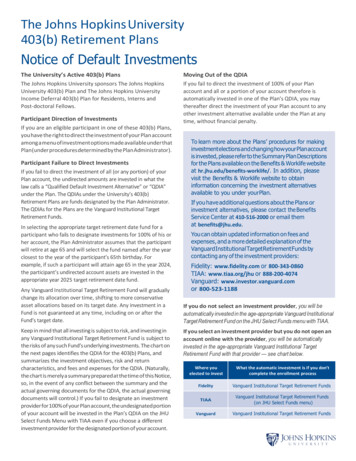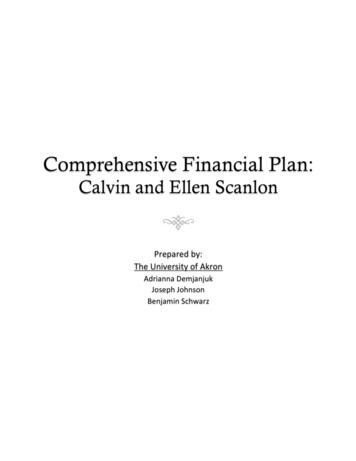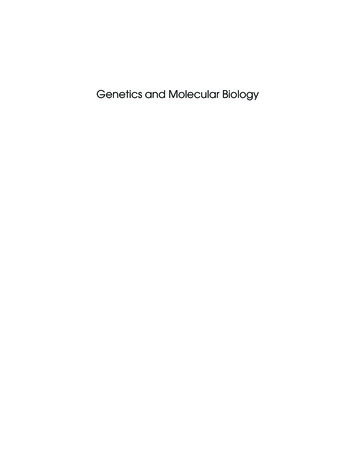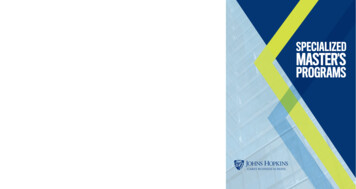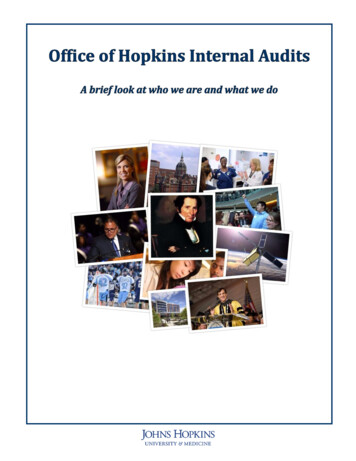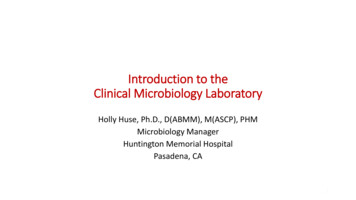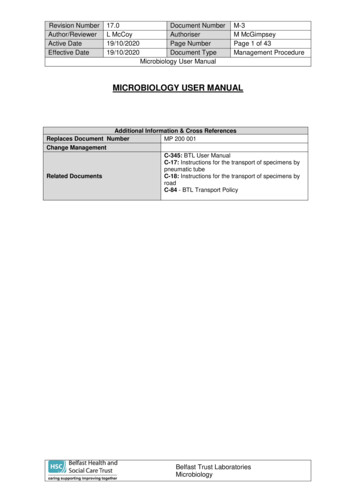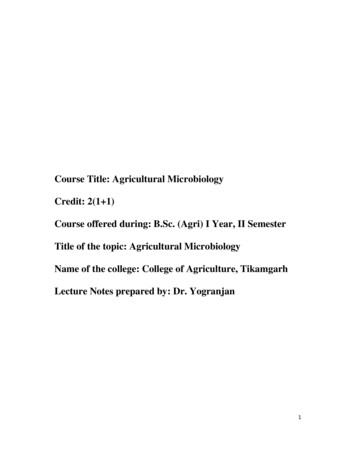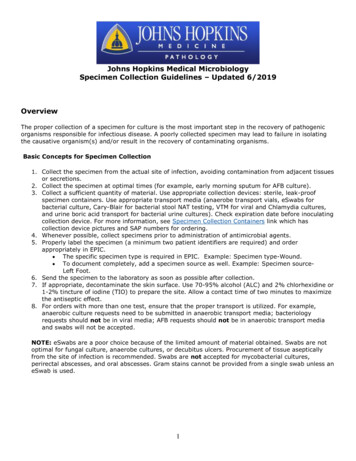
Transcription
Johns Hopkins Medical MicrobiologySpecimen Collection Guidelines – Updated 6/2019OverviewThe proper collection of a specimen for culture is the most important step in the recovery of pathogenicorganisms responsible for infectious disease. A poorly collected specimen may lead to failure in isolatingthe causative organism(s) and/or result in the recovery of contaminating organisms.Basic Concepts for Specimen Collection1. Collect the specimen from the actual site of infection, avoiding contamination from adjacent tissuesor secretions.2. Collect the specimen at optimal times (for example, early morning sputum for AFB culture).3. Collect a sufficient quantity of material. Use appropriate collection devices: sterile, leak-proofspecimen containers. Use appropriate transport media (anaerobe transport vials, eSwabs forbacterial culture, Cary-Blair for bacterial stool NAT testing, VTM for viral and Chlamydia cultures,and urine boric acid transport for bacterial urine cultures). Check expiration date before inoculatingcollection device. For more information, see Specimen Collection Containers link which hascollection device pictures and SAP numbers for ordering.4. Whenever possible, collect specimens prior to administration of antimicrobial agents.5. Properly label the specimen (a minimum two patient identifiers are required) and orderappropriately in EPIC. The specific specimen type is required in EPIC. Example: Specimen type-Wound. To document completely, add a specimen source as well. Example: Specimen sourceLeft Foot.6. Send the specimen to the laboratory as soon as possible after collection.7. If appropriate, decontaminate the skin surface. Use 70-95% alcohol (ALC) and 2% chlorhexidine or1-2% tincture of iodine (TIO) to prepare the site. Allow a contact time of two minutes to maximizethe antiseptic effect.8. For orders with more than one test, ensure that the proper transport is utilized. For example,anaerobic culture requests need to be submitted in anaerobic transport media; bacteriologyrequests should not be in viral media; AFB requests should not be in anaerobic transport mediaand swabs will not be accepted.NOTE: eSwabs are a poor choice because of the limited amount of material obtained. Swabs are notoptimal for fungal culture, anaerobe cultures, or decubitus ulcers. Procurement of tissue asepticallyfrom the site of infection is recommended. Swabs are not accepted for mycobacterial cultures,perirectal abscesses, and oral abscesses. Gram stains cannot be provided from a single swab unless aneSwab is used.1
Johns Hopkins Medical MicrobiologySpecimen Collection Guidelines – Updated 6/2019Contents: By Specimen TypeAbscess . 2Amniocentesis . 3Arthropods . .3Blood. 3Body Fluids, Sterile (except urine and cerebrospinal fluid) . 5Bone Marrow . 6Bordetella pertussis . 6Bronchial Brush/Wash/Lavage . 7Bullae, Cellulitis, Vesicles . 8Cerebrospinal Fluid . 8Cutaneous (Fungal only) . .9Ear . 10Eye . 10Gastric Biopsy .11Genital Sources . 11Molecular Testing .15Nares Surveillance . 17Nasopharyngeal .18Prostate . 19Sputum . 19Stool, Feces . 20Throat . 23Tissue . 24Urine for Bacterial, Fungal, AFB, Parasite and Viral Cultures . 24Viral Transport Media (VTM) . 26Worm ID 27Wounds . 27Abscess1. Decontaminate the surface with 70-95% alcohol and 1-2% tincture of iodine.2. Collect purulent material aseptically: From an undrained abscess: use a sterile needle and syringe.For large abscesses: open with a sterile scalpel and collect the expressed materialwith a sterile syringe.3. Transfer 5-10 ml of the aspirated material to the appropriate transport media based on testbeing requested. See Test Directory for specific guidelines for each test. Note: Anaerobictransport media is not recommended for AFB culture. If requesting AFB culture, transfer atleast 1 ml of the aspirated material into a sterile container.2
Johns Hopkins Medical MicrobiologySpecimen Collection Guidelines – Updated 6/20194. Transport immediately.5. Note requests to rule out Actinomyces sp., Cutibacterium (formerly Propionibacterium)acnes sp. or Nocardia sp. on the requisition/EPIC.Amniocentesis1. Usually collected by ultrasound method by a physician. Send to lab in appropriatetransport based on the tests requested.Arthropod1. Arthropod specimens (ticks, lice, nits, bed bugs, etc.) should be collected using tweezersto remove or extract from the skin if attached. Immerse parasite in 5-10 mL of 70-80percent ethanol (or other alcohol) in a clean container and secure the lid well to preventleaking. Make sure to keep the arthropod as intact as possible, identification isperformed by visual analysis.2. If scabies is suspected, scrape the skin from the leading edge of the lesion. Place in 2-3mL of 70-80 percent ethanol (or other alcohol) in a clean container.3. Identification is performed at a reference laboratory.BloodA. Blood CultureDetermine the type of culture bottles to utilize, as indicated per physician's order (aerobic andanaerobic or resin bottles and anaerobic bottles), or other types as specified below. Please refer to theJHH Interdisciplinary Clinical Practice Manual Blood Culture Procurement Policy and ProcedureAppendix A. 282/appendix 101712.pdf1. Adult Blood cultures: Routine Blood Culture Set: BACTEC FX standard aerobic and BACTEC FX Lyticanaerobic bottleo Used for patients that are not on antibioticsAlternate Blood Culture Set: BACTEC FX Aerobic Plus (resin bottle) and BACTEC FXLytic anaerobic bottleo Patient is on IV or PO antibioticso Patient has been off antibiotics for less than 24 hourso Suspected Neisseria sp. or other fastidious organismsIf absolutely necessary to draw from a central catheter site, utilize the site that hasbeen most recently inserted (unless ruling out catheter sepsis). Follow the procedureas outlined in Appendix A of the JHH Interdisciplinary Clinical Practice ManualInfection Control Blood Culture Policy and Procedure.3
Johns Hopkins Medical MicrobiologySpecimen Collection Guidelines – Updated 6/2019 Send second set of blood cultures using the same procedure as above. If a differentperipheral site is possible, the second set may be drawn immediately. If using thesame site, wait at least 10 minutes for the second set, and if possible (i.e. notwaiting to give antibiotics) draw a third set 1-3 hours later. For complete procedure 39/4282/policy 4282.pdf? 0.0838031674592. Pediatric Blood cultures: Pediatrics shall follow the same policies and procedures as described in this policy.See Appendix B of the ICPM policy (PAT063) Blood cultures: ordering, procurementand icies/39/4282/appendix 101714.pdf? 0.9215683571463. Mycobacterial blood cultures (AFB) Use a Mycobacterial blood culture bottle (BD BACTEC Myco/F Lytic culture bottle).Because the media is unstable, bottles must be obtained from the Microbiology Lab(5-6510 option #1). Pneumatic tube can be used to obtain culture media. Whenreturning the sample to the lab, make sure it is returned in the brown paper bag it issent in to avoid exposure to light.4. Fungal Cultures Candida spp. - If a physician orders fungal cultures, follow routine procedure forbacterial cultures as described above. Cryptococcus, Histoplasma, or other filamentous organisms--obtain anIsolator tube from the Microbiology Lab (call 5-6510 option #1).o Adults: Inoculate isolator tube with 10ml of blood.o Pediatric From children 8 kg body weight Inoculate Pediatric isolator tube with 1.5 ml of blood.5. Viral blood cultures: See Molecular Section4
Johns Hopkins Medical MicrobiologySpecimen Collection Guidelines – Updated 6/20196. When rare organisms such as Brucella, Campylobacter or Bartonella aresuspected: An ID physician shall be consulted. The Microbiology laboratory shall be consulted to advise which type of specimen ismost likely to support the suspected organism.B. Blood Parasites: Malaria, Babesiosis, Trypanosomiasis, and Filariasis1. Draw 3 ml of blood in a lavender top (EDTA) vacutainer tube using the standardvenipuncture procedure.2. Deliver the tube to the Microbiology lab immediately or within 2 hours of collection.3. Indicate patient’s travel history (if available) and suspected pathogen (i.e., rule-outLoa loa filariasis).NOTE: The submission of a single blood specimen does NOT rule out malaria (especially inimmunologically naïve patients); submit additional bloods every 24 hours for up to 3 days ifmalaria remains a consideration.C. Aspergillus galactomannan antigen1. Collect 3-5 mL blood in a serum separator tube (SST) without anticoagulants.2. Transport the specimen to the lab as soon as possible.D. 1-3, Beta-D-glucan test1. Collect 3-5 mL blood in serum separator tube (SST) without anticoagulants or in agold top tube.2. Transport the specimen to the lab as soon as possible.E. HIV Serology1.Collect 6 mL blood in a pink top tube with EDTA2.Transport the sample to the lab as soon as possible.Body Fluids, Sterile (except urine and cerebrospinal fluid)1. Prepare the skin as for Blood culture.2. Collect the fluid using a sterile needle and syringe and place in transport containerbased on test being requested: For aerobic organisms submit 10 ml in a sterile container. (30 mL for pleuralfluid) For aerobic and anaerobic organisms, submit 10 ml in anaerobe transport.(30 mL for pleural fluid)5
Johns Hopkins Medical MicrobiologySpecimen Collection Guidelines – Updated 6/2019 For viral isolation, send 3 ml or less fluid in a sterile vial (1 ml minimum).If mycobacterial or fungal infections are suspected, collect a minimum of 5 mlof fluid into a sterile container. If testing for multiple labs, add up the volume needed, based on the abovevolumes, collect in a sterile container and deliver to the lab within 1 hour.3. Transport immediately.****Do not send Sterile Body Fluids on swabs.Bone Marrow1. Physicians should wear gowns, masks, and gloves during specimen collection.2. Prepare skin as for Blood Culture.3. Drape the surrounding skin with sterile linen.4. Aspirate the marrow percutaneously using a sterile needle and syringe.5. Transfer 3-5 ml for each: Bacterial culture requests, inoculate into a blood culture bottle - do not sendin a heparin tube.AFB culture and fungal culture into a mycobacteria/fungal blood culture bottle(Myco/F Lytic bottle – available in microbiology lab, call 5-6510 option #1).Viral culture-collect into a heparinized (green top) tube.Parvo B19 molecular test into an EDTA (purple top) tube.6. Transport specimens immediately at ambient temperature.Bordetella pertussisCulture and PCR1. Obtain collection system from Microbiology lab, Meyer B-171, 955-6510 option #1.2. Provided in the collection system are two swab/swab transport packages. The package with collection materials for Bordetella pertussis culturecontains a swab with flexible wire shaft (orange handle) and a charcoal6
Johns Hopkins Medical MicrobiologySpecimen Collection Guidelines – Updated 6/2019 tube for swab transport containing black medium into which the swabshould be placed once the specimen has been collected.oTHE ORANGE HANDLED SWAB IS OPTIMIZED FOR BACTERIALCULTURE AND CONTAINS MATERIAL THAT INHIBITS PCR. DO NOTUSE FOR SPECIMENS TO BE TESTED BY PCR.The package with collection materials for Bordetella pertussis PCRcontains a swab with a flexible wire shaft (blue handle) that will be placedinto the accompanying tube containing a sponge for dry transport.Both collection systems can be stored at room temperature.3. To collect the nasopharyngeal swab specimen for culture, remove the orangehandled swab from the package and: Seat the patient comfortably. Tilt the head back. If available, insert a nasal speculum. Press the swab through the naresuntil resistance is met due to contact with the nasopharynx. Rotate the swab gently and allow the swab to maintain contact withthe nasopharynx for 20-30 seconds or until coughing is induced. Place the swab into the transport medium. Label the tube with thepatient's name and identification number. Leave the swab embeddedin the tube during transport.4. To collect the nasopharyngeal swab for PCR, remove the blue handled swab from thepackage and repeat collection steps above after inserting the swab into the alternatenares. Place the swab into the sponge-containing tube. Label this tube with thepatient's name and identification number. Leave the swab embedded in the tubeduring transport.Bronchial Brush/Wash/Lavage1. This technique should be performed by an experienced individual. See HPO procedure:Bronchoscopy and Associated Procedures ENDO628.2. Transport in a sterile container immediately at ambient temperature. Immunocompromised host protocol: 40 mL of BAL fluid Aspergillus galactomannan antigen (Bronchial lavage): Please send 1-2mLfor galactomannan testing (minimum 1mL). Pneumocystis jirovecii, Direct Immunofluorescence stain Submit bronchial washings and bronchoalveolar lavage for PCP testing in asterile container. Testing is performed once daily on weekdays and7
Johns Hopkins Medical MicrobiologySpecimen Collection Guidelines – Updated 6/2019weekends. A second run is performed on BAL’s and bronchial washings onFridays if received by 7:00 PM. On holidays and weekends testing will beperformed on specimens received by 2:00 PM.Bullae, Cellulitis, Vesicles1. Cleanse the skin as for Blood culture.2. Aspirate the fluid/purulent material using a sterile needle and syringe. If an aspirate is obtained, place in appropriate viral or bacterial transport tube orvial. If no material is obtained, unroof vesicle or bullous lesion and use an eSwab tocollect cells from the base of the lesion. Place in appropriate viral or bacterialtransport media.A. CellulitisSwabs and leading-edge aspirates with or without injection of saline fail to yield etiologic agentsin the majority of cases. If an unusual organism is suspected, a leading-edge (advancingmargin) punch biopsy is the recommended. Place the biopsy in a sterile container with a smallvolume of non-bacteriostatic saline and transport to the lab as soon as possible.B. Vesicle Fluids and Scrapings for Viral TestingSelect a fresh vesicle, wipe gently with alcohol, dry thoroughly with sterile gauze. Using atuberculin syringe with a small needle (26 g x 1/2 inch) aspirate vesicular fluid; transfer thefluid to the viral transport medium by filling the remainder of the syringe with the medium,then flush the solution into the transport tube or by swabbing the vesicle and breaking theswab off into a tube of viral transport media. USE STERILE TECHNIQUE AT ALLTIMES. Care should be taken to avoid any bleeding as this can impair recovery of virus indiseases such as Herpes simplex or Varicella zoster viruses since neutralizing antibodies may bepresent in the serum.Cerebrospinal Fluid1. Physicians should wear gowns, masks, and gloves to collect the specimen. Because anopen tube is held to collect the fluid, other personnel should stand away or wear masks inorder to avoid respiratory contamination.2. Decontaminate the skin with 1-2% tincture of iodine, followed by 70-90% alcohol using anincreasingly outward circular movement.8
Johns Hopkins Medical MicrobiologySpecimen Collection Guidelines – Updated 6/20193. Drape sterile linen over the skin surrounding the puncture site.4. Insert the needle. Collect the fluid into three sterile leak-proof tubes. Collect an adequatevolume of fluid as recommended below: bacterial culture 1-5 mlfungal culture 5-10 mlmolecular 1.5-2 mlmycobacterial culture 5-10 mlviral culture 1.5-2 ml5. Cap the tubes tightly. Submit the third tube for culture to reduce the possibility ofcontamination due to skin-microbiota. Transport immediately at ambient temperature.A. CSF for Acanthamoeba and Naegleria sp: Microscopic exam and culture1. Collect 1 ml of spinal fluid in a sterile container.2. Seal tightly and submit to the lab immediately for microscopic examination and culture.3. Transport CSF immediately at ambient temperature.Cutaneous (Fungal only)A. Hair1.2.3.4.Scrape the scalp with a blunt scalpel.Place specimen in a dry sterile container.Transport at ambient temperature.The following specimens are also acceptable: Hair stubs Contents of plugged follicles Skin scales Hair plucked from the scalp with forceps***Cut hair is NOT an acceptable specimen.B. Nails1.2.3.4.5.Cleanse the nail with 70-95% alcohol.Remove the outermost layer by scraping with a scalpel.Place specimen in a dry, sterile container.Transport at ambient temperature.The following specimens are also acceptable: Clippings from any discolored or brittle parts of the nail Deeper scrapings and debris under the edges of the nail9
Johns Hopkins Medical MicrobiologySpecimen Collection Guidelines – Updated 6/2019C. Skin1.2.3.4.Cleanse the skin with 70-95% alcohol.Collect epidermal scales with a scalpel, at the active border of the lesion.Place specimen in a dry sterile container. Do not tape specimen to slide.Transport at ambient temperature.Ear1. External ear cultures are processed as superficial wounds.2. Middle ear fluid will be processed as a sterile body fluid. If the diagnosis is otitis media, thespecimen of choice is middle ear fluid collected by tympanocentesis.3. Please indicate specific ear source.Eye1. Cleanse the skin around the eye with a mild antiseptic.2. Purulent conjunctivitis: Collect purulent material with an eSwab (green cap-mini tip). Place the swab into the eSwab transport media and transport at ambient temperature. This is NOT an acceptable specimen for anaerobe culture. Nucleic acid testing – Chlamydia only: collect specimen with bacteriology culturetteswab and place in 3 ml of viral transport media. Do not use Cobas Collection Kit.3. Corneal infections: Obtain Cornea Pack from the Microbiology Laboratory, Meyer B-171, 5-6510 option #1. Collect multiple corneal scrapings and inoculate directly onto bacterial agar media(chocolate agar, brain heart infusion with gentamicin agar, sheep blood agar, andSchaedler's broth) and/or viral transport media. Transport at ambient temperature. Gram stain is not routinely performed.4. Intraocular fluid: Collect fluid by surgical needle aspiration. Transport cultures at ambient temperature.A. Amoeba Culture: Contact lens, contact lens solution, corneal scrapings/tissuePlease contact the Microbiology Laboratory at 410-955-6510 (option #2) to coordinate amoebaculture. Special media is required. Culture media will be provided to the requesting healthcareprovider to inoculate the specimens at bedside (optimal for recovery). If bedside inoculation is notpossible, please follow directions below for specimen collection:Contact lens and corneal scraping or corneal tissue10
Johns Hopkins Medical MicrobiologySpecimen Collection Guidelines – Updated 6/20191. Submit the specimen in a sterile container with 1 mL of sterile saline.2. Keep at room temperature.3. Deliver to the lab immediately.Contact lens solution1. Submit 2 ml of contact lens solution in a sterile container.2. Keep at room temperature.3. Deliver to the lab immediately.Gastric BiopsyAppropriate for Helicobacter pylori culture only. Contact the Microbiology Laboratory at (410)955-6510 for appropriate transport media. Must be transported to the Microbiology Laboratorywithin one hour of collection. This is sent to a reference laboratory.Genital SourcesRoutinely processed only for gonococcal infections. Predominance of S. aureus, Beta hemolyticstreptococci and yeast reported upon request. Specimens from normally sterile sites (e.g.,transabdominal amniocentesis fluid) can be submitted for anaerobic culture if the specimen istransported to the lab in anaerobe transport medium.For sexually transmitted diseases testing, refer to Chlamydia/Gonorrhea.A. Bartholin's Glands1. Do not use alcohol for mucous membranes. Prep the skin as for regular skin sites.2. Aspirate material from Bartholin gland abscess.3. Send to lab in anaerobic transport medium.B. Cervix (Endocervix) for Culture1.2.3.4.5.Place the patient in the lithotomy position.Prepare the speculum, avoiding the use of a lubricant other than warm water.Insert the speculum and visualize the cervical os.Remove excess mucus with a cotton ball.Insert an eSwab into the cervical os, rotate gently, and allow to remain for 10 to 30seconds.6. Remove eSwab and place in bacterial transport medium.7. Transport at ambient temperature.11
Johns Hopkins Medical MicrobiologySpecimen Collection Guidelines – Updated 6/2019C.Cervix (Endocervix) for HPV DNA Testing1. Samples are referred to Molecular Microbiology from the Johns Hopkins Cytopathologylaboratory. Samples are sent in SurePath collection devices.D. Chlamydia trachomatis/Neisseria gonorrhoeae/Trichomonas vaginalis Nucleic AcidAmplification Tests - Acceptable chomonasvaginalis )Urine(male/female) Chlamydia trachomatis/Neisseria gonorrhoeae/Trichomonas vaginalis Nucleic AcidAmplification Tests - Specimen Collection Procedures Urine Male/Female1. Instruct patient not to urinate at least 2 hours prior to sampling.2. Provide a plastic, preservative-free, sterile urine collection cup with a secure lid.3. Instruct the patient to catch the FIRST 10-30mL of the urine stream. (You may want tomark the outside of the cup to show the desired volume.) Caution the patient not to beginurinating until the collection cup is in position.4. Close the lid securely.5. Transfer urine from the urine cup into the Cobas Urine Collection tube using a transferpipet (provided) until the liquid level rises to between the 2 black lines on the tube.6. Cap and label the tube with patient ID and date.7. Transport the specimen to the lab as soon as possible. Female cervical1. Obtain collection pack from Consolidated Service Center (CSC), SAP number 233352.12
Johns Hopkins Medical MicrobiologySpecimen Collection Guidelines – Updated 6/20192. Wipe exocervix with the white-stemmed sterile swab, removing the excess mucus. Discardthis swab.3. Insert the flocked swab into the endocervical canal. Rotate 10-30 seconds and withdraw.4. Place swab sample into collection tube provided in the Cobas Dual Swab collection kit andbreak off the swab at the scored line. Swab must remain in the transport tube.5. Close the transport tube securely, label and date.6. Transport the specimen to the lab as soon as possible. Female vaginal1. Obtain collection pack from Consolidated Service Center (CSC), SAP number 233352.2. Insert either flocked swab or woven swab about 2 inches past the introitus and gentlyrotate the swab for 10-30 seconds. Ensure the swab touches the walls of the vagina.3. Carefully withdraw the swab without touching the skin.4. Place swab sample into collection tube provided in the Cobas Dual Swab collection kit andbreak off the swab at the scored line. Swab must remain in the transport tube.5. Close the transport tube securely, label and date.6. Transport the specimen to the lab as soon as possible.Note: A single cervical or vaginal swab may be submitted for Chlamydia, Gonorrhea, andTrichomonas testing. Pharyngeal (Male/Female)1. Obtain collection pack from Consolidated Service Center (CSC), SAP number233352.2. Use the flocked swab for collection.3. Swab area between the tonsillar pillars and the region posterior to the pillars.4. Place swab sample into collection tube provided in the Cobas Dual Swab collectionkit and break off the swab at the scored line. Swab must remain in the transporttube.5. Close the transport tube securely, label and date.6. Transport the specimen to the lab as soon as possible. Rectal (Male/Female)1. Obtain collection pack from Consolidated Service Center (CSC), SAP number 233352.2. For ASYMPTOMATIC men: Moisten swab with sterile saline and insert into anus andrectum. Leave for 20 seconds. For SYMPTOMATIC men: Swab rectal mucosa through theanoscope.3. Use the flocked swab or woven swab for collection.4. Place swab sample into collection tube provided in the Cobas Dual Swab collection kit andbreak off the swab at the scored line. Swab must remain in the transport tube.5. Close the transport tube securely, label and date.13
Johns Hopkins Medical MicrobiologySpecimen Collection Guidelines – Updated 6/20196. Transport the specimen to the lab as soon as possible.Gonorrhea Culture Obtain charcoal swab from microbiology, Meyer B-171, 5-6510 option #1.Endometrium Place the patient in the lithotomy position.Insert speculum and visualize the cervical os.Place a narrow-lumen catheter within the cervical os.Insert the tip of a culture swab through the catheter and collect the endometrialspecimen. This method prevents touching the cervical mucosa and reduces thechance for contamination.Place the culture swab into bacterial transport media and transport at ambienttemperature. Urethra Instruct patient not to urinate at least 2 hours prior to sampling. Insert the swab 2-to 4 cm into the urethra. Rotate 3 to 5 sec and withdraw. Place the culture swab into bacterial transport media and transport at ambienttemperature. VaginalVaginal cultures do not often produce meaningful results. Group B Streptococcus will be ruledout on all vaginal cultures. If gonorrhea is suspected, testing by nucleic acid detection isrecommended. Refer to Chlamydia/Gonorrhea/Trichomonas. If yeast infection is suspected, afungal culture should be ordered rather than a routine culture. Group B Streptococcus screening: collect combined vaginal and rectal swab using aculturette. Testing is performed using Lim broth enrichment followed by a nucleic acidtest for detection.Vaginosis/Vaginitis: Collect vaginal swab specimens from symptomatic womenprior to the speculum examination. Note: No lubricant should be used for the sampletechnique. If lubricant must be used for speculum insertion, the lubricant should beused sparingly and applied only to the exterior sides of the speculum blades, avoidingcontact with the tip of the speculum.Use the BD MAX UVE specimen collection kit (available from the CSC: SAP # 242373)and follow the instructions. Hold the collection swab by the cap and insert it into thevaginal opening about 2 inches (5 cm) gently rotating the swab for 10-15 sec. Make14
Johns Hopkins Medical MicrobiologySpecimen Collection Guidelines – Updated 6/2019sure the swab touches the walls of the vagina so that moisture is absorbed by theswab. Withdraw the swab and place it in the UVE sample buffer tubeMolecular TestingVirusQualitative NATAdenovirusSourcesSpecimen Conjunctiva UrineRespiratory(BAL, Endo/naso trach,NP swab, NP washStoolRectal swabBK Virus Urine Sterile containerCMV CSF Amniotic fluid, urineSterile Eye CSF collection container, tube #3Sterile container0.5 mL Vitreous/Aqueous humorin sterile tube/syringe; cornealscrapings in viral transport media(VTM or UVTM)EBV CSF CSF collection container, tube #3Ent
Johns Hopkins Medical Microbiology Specimen Collection Guidelines - Updated 6/2019 5 6. When rare organisms such as Brucella, Campylobacter or Bartonella are suspected: An ID physician shall be consulted. The Microbiology laboratory shall be consulted to advise which type of specimen is most likely to support the suspected organism.
